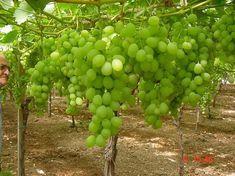
Italy grows more table grapes than any other country in the world. It accounts for 21 per cent of all grapes harvested.
Production is centred mainly in the regions of Puglia and Sicily. Puglia accounts for 67 per cent of all production and some 150 exporters are based in the region. Sicily accounts for 27 per cent. Production is on 72,445 hectares to give a national crop of 1.35 million tonnes, of which nearly 40 per cent is exported.
Italians are huge consumers of their own fruit, eating 8.6kg of grapes each a year. The main markets for their fruit are in the EU although eastern Europe and overseas destinations such as Canada, the US and Middle East also play an important role. Sendings to Germany top the table as the single biggest market at 162,490t in 2003 with the UK accounting for some 9,1180t, although this was just two-thirds of 2002 figure to the UK.
“The biggest development in all the major markets is the growing significance of the major multiples in the sale of fresh produce,” says Carlo Bianchi of the Italian national association of importers and exporters of fruit and vegetables ANEIOA. “This is not just in the rest of Europe but even in Italy now, and general and wholesale markets are disappearing.”
The need to adapt is what production in Italy is fast coming to terms with on the grape scene.
Richard Hochfeld Group (RHG) has been involved in the Italian grape business for six years and handles mainly Sugraone from mid-July to mid-August. “Italy has shifted towards seedless varieties in response to the market in the UK, although they do still produce a lot of seeded grapes for the home market as well as Germany and Spain,” says the importer’s Neil Denny. “Imports into the UK are increasing as they develop more seedless varieties and growers have recently begun producing Thompson and Crimson Seedless in an effort to extend their marketing windows.”
But there is still a long way to go. Alfred Price is one of the best-known names in the grape business in the UK. “Italy used to have the European market to itself once Spain finished,” says Phil McCaughrean, responsible for Italian procurement and sales manager on the wholesale desk of the Liverpool-based importer. “It still does on Italia, but when it comes to seedless, Greece has the quality. Italy has become a gap-filler on white seedless whereas Greece has Thompson Seedless, Italy has Sugraone which is not as popular.”
But at RHG, Denny believes there is an important role for Italy. “It usually starts just after duty is imposed on Egyptian, Israeli and Moroccan product which makes it a more viable alternative,” he says. “The Spanish fruit is a little earlier in the market and usually comes to a close around the end of July. Fruit from Greece usually starts around the Assumption Day holiday on August 15, so that leaves a natural, two-to-three-week window for Italian produce.
The story is a little different on red grape where Italian and Spanish seasons run more or less concurrently and both sources can produce good Crimson Seedless at the critical time. “This last season was a difficult one which started with a cold wet spring,” says Denny. “This caused problems with uneven size although generally that was minimised in the field. As with most other European and North African sources, the season started late, although this did not cause too many problems as the Greek season also started late, therefore the window still existed. Crimson was not easy and colour was slow to develop. This did lead to shortages, although what fruit did arrive confirmed the belief that Italy can be a major source in the future.”
The main varieties in Italy in terms of seedless are: Sugraone, Crimson, Autumn Royal and Thompson and on the seeded side Italia, Vittoria, Red Globe and Palieri.
“Over the last few years in our growing areas, production of elongated-shaped berries and packaging configurations more in line with supermarket demands are on the rise,” says Bianchi.
With the seedless trend therefore firmly established, Italy is facing up to a double challenge: research into growing seedless types adapted for Italian conditions and into the benefits of seeded types in order to re-educate a seedless-oriented consumer market.
“We are facing up to competition from other countries on seedless grapes when we do not have the ideal conditions to produce them,” says Matteo d’Aprile sales manager at import-export specialist Società Ortofrutticola Polignanese (SOP) based near Bari in Puglia. “And a research project funded by regional government, national government and university researchers is investigating the theory that the seed is the part of the grape that is best for you.”
The company exports to major European countries - including the UK where its grapes are sold by Lidl - and has adapted its offer and packhouses to suit supermarket demands.
Research is also ongoing into storage techniques to help with season extension and at the Bonomo di Andria research centre in Puglia a semi-industrial-scale trial has been set up to investigate optimum post-harvest management. While the viticulture research institute, ISV, is looking into developing new varieties and production techniques.
“Research on new variety development and lowering the cost of production are the most pressing issues facing the Italian grape sector in the medium to long term,” says Bianchi.
And growers are already finding ways of squeezing costs out of the chain. “Cultivation practices are very good, leading to good quality dependable fruit with competitive production costs,” says Denny. “Most suppliers in Puglia also supply cherries just before the grape season as well as seeded grape up to Christmas. This means they are able to run packing facilities for much longer periods and has helped encourage large scale investment into facilities in Italy.”



